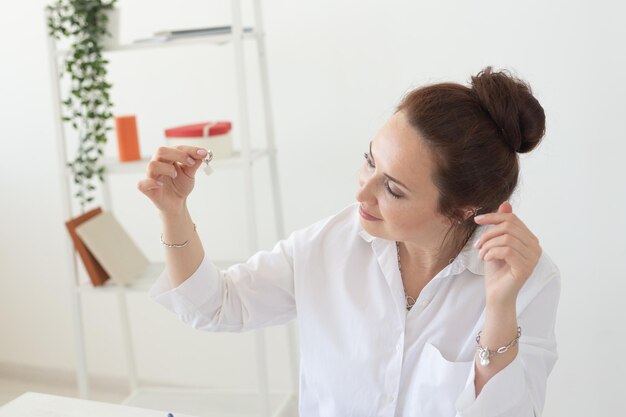Recognizing Skin Cancer: Understanding the Signs and Symptoms
When it comes to skin cancer, early detection is crucial. The skin, being the body's largest organ, is constantly exposed to sunlight and other environmental factors that can increase the risk of cancer. But how do you know if you have skin cancer? Understanding the warning signs and knowing what to look for can empower you to take action if needed.
What is Skin Cancer?
Skin cancer occurs when skin cells grow uncontrollably, often due to the damage caused by ultraviolet (UV) radiation from the sun or tanning beds. There are three primary types of skin cancer:
- Basal Cell Carcinoma (BCC): The most common type, accounting for about 80% of all cases. It often appears as a painless bump that might be pearly or waxy.
- Squamous Cell Carcinoma (SCC): The second most common type, which might look like a firm, red nodule or a flat lesion with a scaly crust.
- Melanoma: The most dangerous form, known for its ability to spread rapidly. This cancer type might resemble a mole or grow from a mole.
Recognizing the Warning Signs
Being proactive about noticing changes in your skin is essential. Here are some key signs to watch for:
The ABCDEs of Melanoma
This easy-to-remember guide helps you identify suspicious moles or spots that could be melanoma:
- Asymmetry: One half of the mole doesn't match the other half.
- Border: Edges are irregular, ragged, or blurred.
- Color: Varied shades of brown, black, or even patches of red, white, or blue.
- Diameter: Larger than 6mm (about the size of a pencil eraser).
- Evolving: Changes in size, shape, color, or feel.
Other Symptoms
- Sores that do not heal
- Redness or swelling beyond the border of a mole
- Itchiness, tenderness, or pain in a mole
- Changes in the skin's surface such as scaliness, oozing, or bleeding
How to Perform a Self-Examination
A self-examination is a practical way to keep track of any new or changing spots on your skin. Here’s how you can do it:
- Stand in front of a full-length mirror and use a hand mirror for hard-to-see areas.
- Examine your entire body, including palms, soles, scalp, ears, and under your nails.
- Make note of any new spots or changes to existing moles, freckles, or birthmarks.
Understanding Your Risk Factors
Certain factors can increase your likelihood of developing skin cancer. Be aware if you have:
- Fair skin, light hair, and eye color
- A history of sunburns or excessive UV exposure
- A personal or family history of skin cancer
- Numerous moles or atypical (dysplastic) moles
- A weakened immune system
What to Do If You Spot Something Suspicious
If you notice a new mole or a change in an existing one, it doesn’t automatically mean you have skin cancer. However, it is important to see a healthcare professional, particularly a dermatologist, for further evaluation. Here’s what you can expect:
- Dermatological Examination: A thorough inspection of your skin by a specialist.
- Biopsy: If required, the doctor may perform a biopsy to check for cancerous cells.
- Regular Follow-Ups: Scheduling follow-up visits to monitor your skin.
Prevention: Protecting Your Skin
Prevention is better than cure, and this applies to skin cancer as well. Here are some practical tips for protecting your skin from harmful UV rays:
- Apply Sunscreen: Use a broad-spectrum sunscreen with at least SPF 30 daily, even on cloudy days.
- Wear Protective Clothing: Long-sleeved shirts, wide-brimmed hats, and sunglasses can block direct sun exposure.
- Seek Shade: Avoid outdoor activities when the sun's rays are strongest, typically between 10 a.m. and 4 p.m.
- Avoid Tanning Beds: Artificial UV light can increase your risk of skin cancer significantly.
Emotional Well-being and Support
Receiving a diagnosis or even the suspicion of skin cancer can be overwhelming. It’s important to focus on mental health in these situations:
- Seek Support: Connect with support groups or counselors to share your feelings and gain perspective.
- Educate Yourself and Others: Knowledge about skin cancer can alleviate fears and empower you to make informed decisions.
- Practice Stress-reducing Activities: Engage in activities like yoga, meditation, or any hobbies that help relieve stress.
Empowering Yourself with Knowledge
While skin cancer is a serious condition, being informed and vigilant can significantly reduce its impact on your life. Understanding the potential signs, risk factors, and protective measures can help you take control of your skin health. Remember, early detection is key, and regular check-ups can make a significant difference.
By keeping these insights in mind, you can lead a proactive lifestyle that not only looks out for signs of skin cancer but also prioritizes overall well-being. Stay aware, stay informed, and take steps to protect your skin every day.
Quick Reference Guide to Skin Cancer Awareness 🌞
- Know the ABCDEs: Check moles for Asymmetry, Border, Color, Diameter, Evolving changes.
- Perform Regular Self-Checks: Examine your skin monthly for new or changing spots.
- Understand Risk Factors: Light skin, sunburn history, and family history increase risk.
- Prompt Action: See a dermatologist if you spot suspicious changes.
- Prioritize Protection:
- 🎇 Use sunscreen with SPF 30+
- 👒 Wear protective clothing
- 🕶️ Seek shade, especially midday
- 🚫 Avoid tanning beds
- Embrace Support: Don’t hesitate to reach out for emotional and mental support when needed.

Related Articles
- Are Breast Cancer Lumps Painful
- Are Chills a Sign Of Cancer
- Are Colon Spasms a Sign Of Cancer
- Are Lytic Lesions Always Cancer
- Are Polyps Cancer
- Can a Blood Test Detect Cancer
- Can a Ct Scan Detect Cancer
- Can a Dexa Scan Show Cancer
- Can a Gastric Emptying Scan Show Cancer
- Can a Lung Biopsy Cause Cancer To Spread